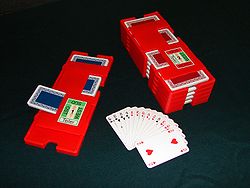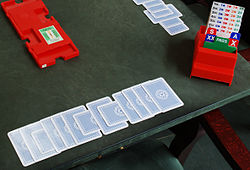Board - bridge
|
Rectangular aluminum board
|

Leather or pliable plastic wallet-style board |
In duplicate bridge, a board is an item of equipment that holds one deal, or one deck of 52 cards distributed in four hands of 13 cards each. The design permits the entire deal of four hands to be passed, carried or stacked securely with the cards hidden from view in four pockets. This is required for duplicate bridge tournaments, where the same deal is played several times and so the composition of each hand must be preserved during and after each play of each deal.

Stacked plastic boards with cards inserted |
Each board is usually marked with the following information: board number - (usually in the sequence '1' to '32') identifies the deal and helps to order the play of multiple deals; compass directions - used to match the four hands to the four players at a table; dealer - designates which player is the "dealer"; this designates the player who is to make the first call of the auction; vulnerability - often represented by color code: a "vulnerable" partnership is usually shown in red and a "not vulnerable" partnership in green, white or no color. Most designs include a slot or pocket to hold a paper travelling score sheet.
Colloquially, the term board may refer to one deal plus its bidding and play. When bridge is played online, there are no physical boards, nor physical cards, but the software emulates all of the features of duplicate boards and the unit of the game is commonly called a board.
History
First used in duplicate whist in the 1890s, the devices were called duplicate whist trays. Since the first in November 1891, numerous patents have been registered incorporating a variety of shapes, sizes and materials and having various means of inserting and retaining the cards in place in the trays or apparatus, as they were often referred to in the patent description. Amongst the earliest versions were those manufactured by Ihling Brothers & Everard of Kalamazoo, Michigan, and referred to as the Kalamazoo Tray, a square tray, getting award winning recognition at the 1893 Chicago World Fair. The company's interests in duplicate whist trays were purchased by The Duplicate Whist Co. in 1899, which introduced a tray known as the Paine's Duplicate Whist Tray after its President, Cassius M. Paine; Paine used the U.S. Playing Card Co. of Cincinnati as his sole manufacturing and sales agent.
Originally, trays were sold in sets of 8, 12, 16 and 20; subsequent to the introduction of the concept of vulnerability to contract bridge in 1926 and the adoption of boards for duplicate bridge, a set consists of 16 (or 32) boards owing to the 16 possible deal combinations arising from the four states of vulnerability for each of the four dealer positions. By the mid-1930s, thirty or forty different types were being sold. The first oblong boards were made of paper by William McKenney in 1928; the first metal boards were by F. Dudley Courtney in 1931.
The most common modern boards are rectangular in shape and made of plastic replacing earlier models made of paper covered pasteboard, sheet metal, wood and more recently aluminum. Boards designed as foldable wallets, originally made of leather, primarily used in England, are now generally made of pliable plastic. While the concept for the contract bridge duplicate board evolved from the duplicate whist tray,
...it is called a "board" rather than a "tray" stems from the fact that the earliest widely accepted models were made of wood.
Set of boards
A set of boards for duplicate bridge typically contains 32 boards and as many as 36. The actual number of boards used in a particular session depends on the type of tournament, the number of tables, and the choice of movement used. Often some of the higher numbered boards (e.g. 25 to 36) are not required to be used owing to limits on the duration of a play session. The dealer and vulnerability markings for each board number are standardized in the laws of the game, utilizing all the possible permutations. The dealer is rotated clockwise in successively numbered boards. Four combinations of vulnerabilities also change, but they are also shifted circularly after every four boards. Thus, a set of 16 boards has the following markings:
| Board |
Dealer |
Vul. |
|
Board |
Dealer |
Vul. |
|
Board |
Dealer |
Vul. |
|
Board |
Dealer |
Vul. |
| 1 |
N |
None |
5 |
N |
N-S |
9 |
N |
E-W |
13 |
N |
All |
| 2 |
E |
N-S |
6 |
E |
E-W |
10 |
E |
All |
14 |
E |
None |
| 3 |
S |
E-W |
7 |
S |
All |
11 |
S |
None |
15 |
S |
N-S |
| 4 |
W |
All |
8 |
W |
None |
12 |
W |
N-S |
16 |
W |
E-W |
The scheme is repeated in the subsequent set of 16 (i.e. on boards numbered 17-32) and boards 33-36 repeat the scheme of boards 1-4.
Preparation of the deal
At the beginning of a session, the boards are prepared in one of several ways:
- Predealt - the sponsoring agency has prearranged the cards in the boards, and the boards are given to the players "ready for play".
- Player shuffle - before the start of play, each table receives a number of boards each containing 13 cards in each of its four pockets. The cards are removed from the pockets of a board by the players, shuffled together and dealt into four equal piles. Each pile is placed into a pocket of the same board. Each board is prepared in the same manner and stacked in numerical order ready for play. The players prepare the different boards simultaneously; it does not matter which player prepares which board.
- Computer 'shuffled' - as in the foregoing, each table receives a number of boards to prepare. In addition, each board is accompanied by a hand record which identifies which specific cards are to be distributed to each hand for that board. The hand records are usually prepared in advance by a computer program using a pseudorandom number generator. The cards are removed from a board and sorted by suit. The players cooperate in dealing the cards according to the hand record and in placing the correct cards in their assigned pocket of the board. Each board is prepared in a similar manner and stacked in numerical order. The boards will be passed to another table ready for play and will not be played by those who prepared them.
- Computer 'shuffled and dealt' - the deal is generated randomly by computer algorithms and dealt by machine directly into boards specially designed for the purpose. This is the most common method used in modern tournament play.
No matter how the boards are prepared, they are not shuffled again during the session, and the cards in all pockets are kept face down. Sometimes, at the end of a session or the beginning of a new session, a card or cards will be placed in the board face up. This indicates that the board has not yet been prepared for the new session.
The board may also carry a travelling sheet - a paper form where players enter their scores each time the board is played. The board may contain a dedicated pocket for the travelling sheet (folded so as to hide the entries from view between scorings); otherwise it can be inserted in the slot with the cards for North, the score recorder. In many clubs and almost all higher level tournaments, the travelling sheets have been replaced by small electronic data recording devices stationed at each table.
Play

The orientation of the cards indicates that the partnership has lost the third, seventh and ninth tricks and won the other ten.
Play of each board proceeds as follows:
- The North player positions the board in the centre of the table (perhaps at the top of a stack of boards), making sure that it is correctly oriented so that each player's cards are nearest to him.
- Each player removes the cards from the pocket corresponding to their playing position at the table (i.e. North, East, West or South).
- Each player counts his cards before looking at any card face. The director is summoned if any player does not have exactly thirteen cards.
- The players look at their cards (without showing any card face to any other player at the table) and optionally arranges them in order (e.g. by suits) according to personal preference.
- The player designated as the dealer on the board makes the first call and the bidding proceeds clockwise until a final contract is established.
- The player to the left of declarer initiates play to the first trick by making the opening lead.
- After the opening lead is made, each of the remaining players follows in clockwise rotation, showing a card face or placing a card face up on the table in front of him. The cards are not mixed together as they are in rubber bridge trick collection.
- After four cards are played to a trick, each player turns his card face down and places it in a row in front of him, overlapping left to right. If that player's side won the trick, it is placed straight up (pointing towards one's partner); otherwise, it is laid sideways (facing your opponents), so that it is clear how many tricks each side has won at any time. If a player orients his card the wrong way, his partner may point out the error.
- The play to all subsequent tricks is initiated by the lead of a card by the winner of the previous trick.
- After the play, the number of tricks won by each side is agreed. If all player's cards show the same orientation of cards, there is usually quick agreement; if one or more of the cards are not similarly oriented, a review of the tricks in the order played will usually determine where the difference has occurred so that errors can more easily be corrected by mutual agreement.
- Each player then gathers only his own cards, shuffles them and replaces them face down in the board pocket from which they came. The shuffle ensures that the next player can make no inference from the order of the cards in the pocket.
- If in use, the travelling scoresheet is removed from its slot, the score and other details for the board are written on the scoresheet by North and checked by East or West, and the scoresheet is then replaced in its pocket or slot in the board. Alternatively, the score is entered into the electronic scoring device by North and checked and accepted by East or West.
COMMENTS



 Leather or pliable plastic wallet-style board
Leather or pliable plastic wallet-style board Stacked plastic boards with cards inserted
Stacked plastic boards with cards inserted The orientation of the cards indicates that the partnership has lost the third, seventh and ninth tricks and won the other ten.
The orientation of the cards indicates that the partnership has lost the third, seventh and ninth tricks and won the other ten.